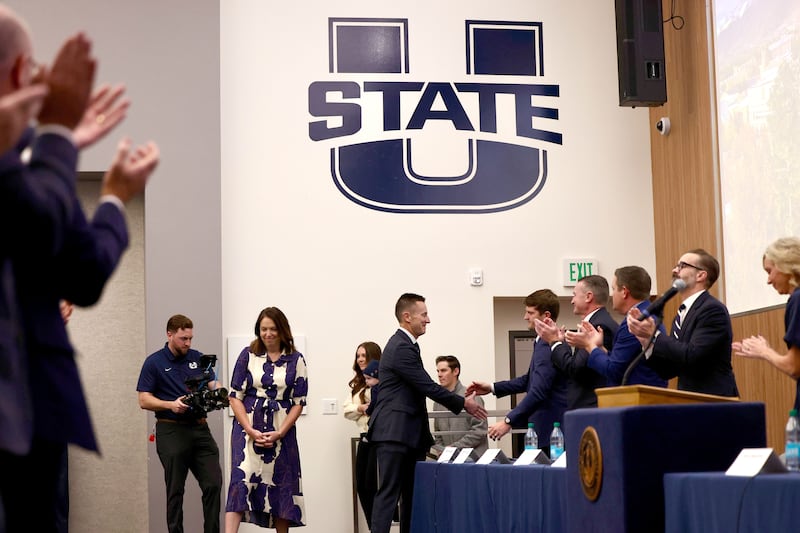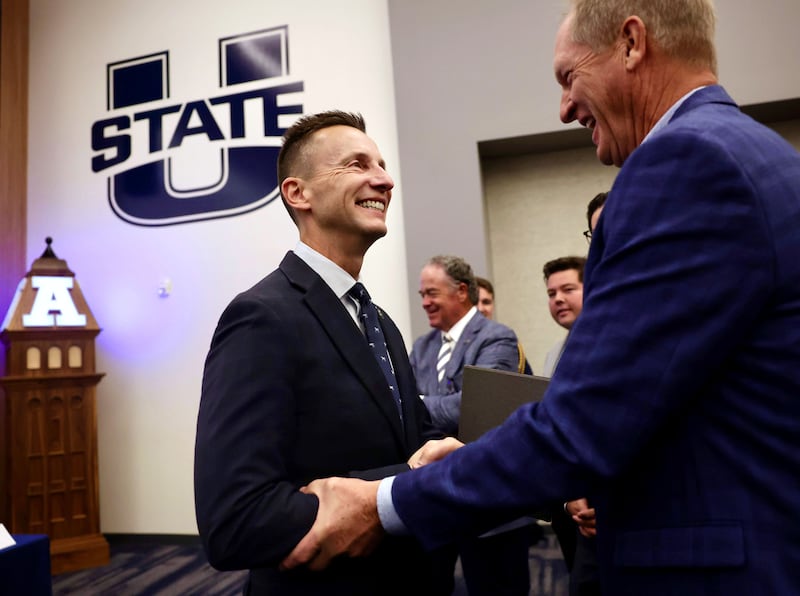- Brad Mortensen appointed Utah State University's 18th president.
- Mortensen has served as president of Weber State University since 2019.
- The new president assumes office at a pivotal period in USU's history.
Utah State University has a new chief.
On Thursday, the Utah Board of Higher Education announced Brad Mortensen will be the 18th president of the state’s only land-grant university.
Mortensen replaces former President Elizabeth Cantwell, who was hired in 2023.
Cantwell resigned in February after being selected as president of Washington State University.
USU’s new president — who was unanimously approved by the board during a meeting on campus — is a familiar face in Utah higher education.
Since 2019, he has served as president of Weber State University.
He will begin his service at USU on Nov. 10, 2025.
“This is incredibly humbling — and almost unbelievable. … Go Aggies!,” said Mortensen in his first remarks as USU’s new president.
Mortensen is a USU alum, claiming a bachelor’s degree in political science before moving on to pursue graduate studies.
In his introductory remarks Thursday, he pledged to lead the school with integrity and earn the trust of the USU community.

Mortensen also noted his appreciation for Weber State University and the relationships he’s developed on the Ogden campus over the past six years.
A first-generation college graduate, Brad holds several degrees, including a doctoral degree in educational leadership and policy from the University of Utah.
Following Cantwell’s departure, Alan Smith was named as USU’s interim president. He is expected to return to his position of the dean of the Emma Eccles Jones College of Education and Human Services.
How Mortensen hopes to empower fellow Aggies
In front of a packed hall gathered for Thursday’s announcement on the USU campus, Mortensen marveled that a first-generation college graduate and a proud Aggie alum would be returning to Logan to lead his alma mater.
“It is,” he said, “unbelievable.”
USU’s new president added he “is truly excited” to reconnect with Aggie Nation. He pledged to lead “with transparency, integrity and love” while building “a bright, bright future for Utah State University.”
Mortensen envisions USU seizing research opportunities and also empowering its students.
The university, he said, can be a place of “world-changing” discovery while ensuring “that every single Aggie is equipped with the knowledge, skills and resilience that they need to define their future success — and to lead the next generation of innovation for our state and for the globe."
Mortensen saluted his parents — Leon and Barbara Mortensen — for encouraging him and his brothers to pursue higher education “so that we would never be locked-out from any opportunity.”
During Mortensen’s WSU leadership tenure, the school witnessed historic enrollment growth.
He established the Miller Advanced Research and Solutions (MARS) Center in partnership with the Utah Legislature, while overseeing the establishment of new graduate programs — including the Doctor of Nursing Practice.
Other key WSU accomplishments include pioneering the first accelerated bachelor’s degree programs in the public school system and securing nearly $400 million during his tenure to enhance academic, athletic and research facilities.
“Dr. Mortensen is a visionary leader who understands the potential and responsibility of leading USU,” said Amanda Covington, chair of the Utah Board of Higher Education. “He has a proven record of delivering value for students and Utahns, ensuring mission-critical decisions lead to improved student outcomes and a thriving economy.
USU Board of Trustees member David Huntsman, who co-chaired the search committee for the new president, said Mortensen stood out in the candidate search “for his practical, student-centered approach and his deep understanding of Utah’s higher education landscape.”
Thumbs-up from Utah government leaders
Mortensen’s USU appointment was applauded Thursday by a fellow Aggie, USU graduate Gov. Spencer Cox.
“Congratulations to President Brad Mortensen on being named the new president of Utah State University,” said Cox in a statement.
“President Mortensen has demonstrated outstanding leadership at Weber State University by prioritizing student outcomes, supporting faculty and staff, and engaging with the larger community.
“I am genuinely excited for the vision and leadership he will bring to Utah State University.”
Added Utah House Speaker Mike Schultz:
“This is an exciting moment for one of Utah’s key institutions of higher education,” said Schultz in a statement.
“Leading USU is both a tremendous responsibility and an exceptional opportunity, and we are confident that with (Mortensen’s) experience, vision and leadership, the university will continue to reach new heights.
“Having worked with President Mortensen during his tenure leading Weber State, we have seen firsthand his remarkable ability to inspire, innovate and deliver results.”
Utah Senate President Stuart Adams called Mortensen “a visionary leader” who works effectively with lawmakers and looks out for the needs of the students.
“His focus on innovation, access and student success made Weber State a national leader in concurrent enrollment,” wrote Adams. “Though his leadership will be missed at WSU, Utah State’s future is bright under President Mortensen’s guidance.”
Helping today’s USU students discover their own paths to success
In an interview minutes after the announcement, Mortensen told the Deseret News he remembers well being a newly arrived undergraduate trying to figure his way out around the USU campus.
That humility remains as he works now to gain the trust of the USU community, helping each student “find that path” to their own success and discovery.
USU, he added, was for him an institutional vehicle to career opportunities that his parents did not enjoy.
Mortensen called his hard-working father “the smartest person I know.” But Leon Mortensen faced professional obstacles because he lacked a college degree. “And he was not going to let his sons face that same barrier.”
While much has changed since Mortensen’s first foray into higher education as a young student, he said the promise and opportunities found at institutions such as USU remain.
Mortensen confessed Thursday to a mixture of emotions as he prepares to move 45 miles north from Ogden to Logan. He spent more than two decades at Weber State, building lifelong academic relationships and friendships across campus.
“I will always cherish those moments and those memories at Weber — and I’m so proud of what we did together.”
Now, he said, he’s excited for the opportunities that await in his return to Logan.
The entire USU system, he said, “provides tremendous value and high-quality, life-transforming opportunities for students.”
Higher education in Utah and across the country has witnessed historic disruption over the past few years. And academic leaders such as Mortensen are often being asked to defend the value of a college education.
USU’s new president acknowledged that changes to federal funding for research could exact a significant shift in how research enterprises operate at the school.
“I want to understand that and then strategize on how we can effectively advocate and perhaps find new or additional funding streams to support the vital research that’s happening here.”
Mortensen remains a vocal champion of the value of a college education.
“The backbone of our society — the teachers, the nurses, the social workers, and the accountants that we need just for our communities to function — none of that happens without higher education.
“So I see part of my role as president is trying to impact that narrative.”
Mortensen added the decision to return to Logan to become his alma mater’s president was a family matter shared with his wife, Camille, and their four children.
“As my wife says, these are not just jobs, they’re lifestyles — and they impact everybody.”
Challenging moments at USU
Mortensen assumes the reins at Utah’s only public land-grant research university at a volatile period in the school’s history.
Last August, lawmakers ordered a broad audit of spending processes at USU after an initial review discovered several concerns.
The call for a deeper analysis of USU’s policies and practices follows a limited review from the Office of the Legislative Auditor General of the school’s President’s Office.
Legislative auditors recommended the full audit after the Office of the Legislative Auditor General examined several USU procurement areas — including the school’s spending policies; purchase orders for legal, professional and consulting service; procurement card transactions from the President’s Office and asset tracking related to the president.
In their report to lawmakers, state auditors identified “several risks” regarding structure, governance and leadership concerns that suggested a full audit at USU was in order.
Identified risks included issues with the design and implementation controls of procurement policies and concerns that USU’s board of trustees and senior leadership may not be providing sufficient oversight on key procurement and administrative matters.
Additionally, the report noted that over the past two years, purchase card transactions with the President’s Office had significantly increased compared to the previous five years — including the amount spent on presidential motor vehicle assets.
USU moves past its Title IX compliance review

And last month, the Department of Justice announced it had closed its five-year Title IX compliance review of USU.
In 2020, the DOJ and USU entered into a settlement agreement addressing the federal department’s findings that the university violated Title IX in response to allegations of sexual harassment, including sexual assault.
The DOJ launched an investigation in 2017 based on allegations that the university failed to respond to numerous reports of serious sexual assaults — including a high-profile case that alleged former Aggie football player Torrey Green had sexually assaulted several women.
USU reports making “sweeping changes across policies, training, campus culture and organizational structure” — while revising its sexual misconduct, grievance and reporting policies.
And like other degree-granting colleges in Utah USU was required by the Legislature to reallocate 10% of its budget to programs determined to be “high value” as part of House Bill 265 — the so-called “Higher Education Strategic Reinvestment” plan.
The reinvestment plans for the other Utah colleges and universities were approved by the Legislature — but USU’s final plan pending approval was placed on hold until it could be examined and revised by the school’s new president and then presented to the Utah Board of Higher Education for assessment.


